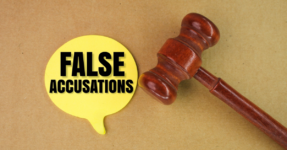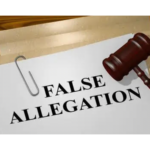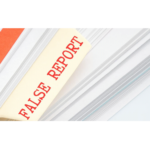False Accusations and Wrongful Convictions: How Lives Can So Easily Be Ruined

The mainstream media is in the habit of assuming guilt upon suspicion, let alone charge: that a person suspected of a criminal offence is likely to be guilty and, if charged by police, must be guilty – that where there’s smoke, there’s fire.
But the fact of the matter is countless lives have been ruined by sensationalised misrepresentations by the media, police and even politicians – a narrative that assumes guilt and one which, when presented, can be impossible to erase despite overwhelming evidence to the contrary and the fact a person of interest or suspect is never charged, or are put through the ordeal of criminal prosecution and ultimately have their charged withdrawn or dismissed in court.
And often, when charges are never brought, withdrawn, or dismissed, the media fails to cover that fact with the same vigour they seek to crucify the innocent or frame the occurrence in a way that suggests the hapless person has somehow evaded justice through legal loopholes or the insufficiency of evidence despite their guilt.
But such is the state of media and, indeed, the criminal justice in Australia – a system whereby nefarious actors such as ‘journalists’ intent on obtaining a story and single-minded law enforcement agents and, indeed, prosecutors intent on obtaining a conviction despite the human cost can ruin innocence lives with virtual impunity – a situation exacerbated by the absence of restrictions against publishing the details of persons of interest and suspects before they are charged, recently-enacted hurdles and defences to defamation prosecutions, ever-expanding police powers and immunities, and the deference to junk science and misrepresented forensic evidence in the courtroom.
That said, here are a few of Australia’s most highly-publicised wrongful convictions.
Kathleen Folbigg
One of the most infamous and recent wrongful conviction cases involves Kathleen Folbigg, an Australian woman who was wrongfully convicted over 20 years ago of murdering her children. Folbigg’s four infant children died in a short period between 1989 and 1999, all dying suddenly when they were aged between 19 days old and 19 months old.
The Australian courts convicted Folbigg of murdering all of her children by smothering them. The innocent woman received three counts of murder and one count of manslaughter in one of the most highly-followed and publicised trials that have ever occurred in the country. Folbigg was sentenced to 40 years in prison, all the while maintaining her innocence throughout the years.
In 2018, new evidence discovered that two of Folbigg’s children had a rare genetic condition that could have led to their sudden deaths. Further research confirmed that her other two children also carried a different, rare genetic mutation that changed the children’s cause of death to that of natural causes.
In 2022, a government inquiry recommended that the New South Wales Court of Criminal Appeal should consider clearing Folbigg’s convictions, noting that there were no ‘signs of smothering’ on the children and that the new evidence introduced indicates the children died of natural causes. In June of the same year, Folbigg was eventually pardoned by the NSW Governor and released from prison.
Bob Chappell
Another well-known possible wrongful conviction case in Australia is that of the Susan Neill-Fraser trial and Bob Chappell’s murder. Neill-Fraser is currently serving a 23-year sentence for the supposed murder of her husband, Chappell, after being found guilty by the Australian court system.
Despite Chappell’s body never being found, the justice system still proceeded to find the woman guilty of murder. However, Neill-Fraser’s legal team, family, and supporters state that she was wrongfully convicted solely on circumstantial evidence and suffered from a grave miscarriage of justice.
Furthermore, errors have been found in the case, notably mistakes made in the initial screening test. Even with possible reasons to reopen the case or accept Neill-Fraser’s appeal, the courts remain steadfast that Neill-Fraser acted alone to murder her husband.
Lindy Chamberlain
Arguably, the most famous wrongful conviction incident in Australia, and maybe the world, was that of Lindy Chamberlain and the ‘dingo took my baby’ true crime case that shook the country to its core.
Lindy Chamberlain and her husband, Michale Chamberlain, went camping with their nine-week-old infant, Azaria, near Ayers Rock in August 1980. The nine-week-old baby disappeared from their tent, and Lindy reported seeing a dog leaving their tent. What followed was just as cruel and horrifying as the incident itself.
In the general public, both Lindy and Michael were shamed, abused, and ridiculed for what people believed to be the murder of their infant baby. The Australian public’s vilification of the couple, specifically Lindy, coupled with the police leaking information to reporters, fueled the hatred of the parents by the entire country.
Despite maintaining her innocence throughout the trial, Lindy was convicted of murder and sentenced to life imprisonment in October 1982. The husband only received an 18-month suspended sentence for an accessory to murder. However, their baby’s matinee jacket and dingo hair were found in Uluru, indicating the parents might be telling the truth about what happened. Therefore, she and her husband were exonerated on all charges in 1988.
It took almost 15 more years for a coroner to officially reveal an official report stating that a dingo took Azaria, attacked, and killed — verifying what the couple had said from the onset.
Bondi Killer
A Sydney man was falsely accused of being the Bondi Junction killer via social media. Ben Cohen was named as the killer on social media, and a statewide TV program before police named Joel Cauchi as the killer. However, the damage had already been done.
Cohen ended up settling out of court with the TV giant, Seven, as they falsely accused and named him on their Sunrise Program. Although he was able to settle this matter outside of the court system, he urged social media platforms to be accountable for what they post.
Bill Spedding
Bill Spedding became a key person of interest to the NSW Police when he was accused of being involved in the disappearance of 3-year-old William Tyrell in 2015. Strike Force Rosann was in charge of leading the investigations into the disappearance of the toddler from Kendall on the NSW Coast in 2014. They discovered that Spedding had visited the home of William’s foster grandmother three days before he went missing — and they used this coincidence, along with his past, to wrongfully target him for the boy’s disappearance.
Spedding went on to sue the state for malicious prosecution, abuse of process, wrongful imprisonment, and misfeasance in public office due to the state using a failed prosecution of him in regard to sexual assault charges that were unrelated to the disappearance.
Prosecutors ‘acted with malice’ while pursuing the charges, coupled with police severely abusing their power to hold Spedding responsible for a crime with no evidence apparent.
Not only did the prosecution incorrectly label an innocent man as a paedophile, ruin his life, and not catch whoever was responsible for a boy vanishing off of his grandmother’s verandah, but it also cost taxpayers an exorbitant amount of money for the force’s legal representation.
Josephine Greensill
Josephine Greensill was a teacher in charge of students on a school trip in 1979. She organised an excursion for a few Year Three students to camp outside in her backyard, providing care and supervision to the students while they were at her residence. Although this may seem outlandish in today’s world, it was considered normal in the 1970s. Despite the night passing without incident, Greensill’s world would come crashing down decades later.
In 2007, both students, who were now in their 40s, accused Greensill of sexually abusing them. Greensill was immediately arrested and charged, later being found guilty of nine charges of child sexual assault and given a 5-year sentence.
Even though a jury found her guilty, she steadfastly maintained her innocence and continually pushed for appeals. Her wish came true in 2012 when the Supreme Court overturned the jury verdict for clear reasons — the two complaints colluded with one another before making a claim, had not hit puberty and were not capable of having intercourse with Greensill as alleged, and there was a lack of forensic evidence.
Eleanor Williams
Eleanor Williams was found guilty of nine charges of perverting the course of justice after making false sexual assault claims.
The story began in May 2020 when Williams posted photos to her social media Facebook page depicting cuts, bruises, and injuries, claiming that a group of Asian men violently assaulted her. The online posts sparked vitriol and hatred from the public towards minorities, unfairly so, along with a ‘Justice for Ellie’ campaign that soon went viral.
Despite the ‘photographic evidence’ posted to her Facebook page, police were unable to find proof of the ‘sex trafficking’ that she claimed. Instead, they found video evidence and fake social media accounts proving Williams lied about the entire ordeal.
But the damage had already been done. Due to spreading misinformation and making false allegations against persons from an Asian country, it had spurred 151 crimes and 83 hate crimes, showing how false allegations can ruin a person’s life, along with a huge fallout in the community as a whole.
Self-Assault Leads to Domestic Violence Charges
In 2018, a Sydney woman repeatedly hit herself to cause injuries and blame them on her husband, fabricating domestic violence charges against him.
The husband met Asmae through Muslima.com, a Muslim dating website. He proposed to her before leaving for Morocco to meet Asmae’s family. Despite wanting to move back home, he purports that Asmae never shared the same vision and used his status to pay for expensive items and feed her extravagant lifestyle.
It all came to a head in April 2018 when the man came home from work and found that their apartment looked like it had been ransacked, as Asmae threatened to take legal action and then ran away.
CCTV footage shows Asmae rushing into the elevator and punching herself twice in the face, later using this physical ‘proof’ as evidence that her then-husband assaulted her. He was arrested and charged with four counts of assault, which could see him imprisoned for up to 7 years.
During the following months, he used a defence team to prove his innocence, which was harder than anticipated. Police refused to get the CCTV footage, meaning the defence lawyer needed to subpoena and obtain the footage to use in tandem with representations for withdrawal of the case.
Despite the CCTV footage, police continually resorted entirely to the complainant’s version of events, even with the victim in this case — the man — participating in an interview with them before seeking legal advice and being adamant that Asmae did this to herself.
This highlights how false accusations are always made — and how police and media go with that narrative.
False Accusation Leads to Suicide
Ashleigh Humphyrs, a 20-year-old man who was intoxicated and trying to get home at 4 am in Toowong by Brisbane CBD on 22 March 2015, was struck and killed by a sedan. The sedan driver was unaware that he had hit someone on the road.
Although hitting someone on the road could be an accident that is not known to the driver, as there are frequent potholes, wildlife, and other items in the road that can cause similar bumps, the police considered this a ‘disgraceful act’, paired with the media calling the driver ‘a coward’.
Police and media scrutiny are two huge variables when it comes to false accusations and wrongful convictions, as they often fuel hatred and vitriol towards the person who is accused of such a crime — even though they may be falsely accused or unaware that a crime even took place. In this instance, the pressure and accusations towards the driver — a 57-year-old father — made him take his own life less than a week after the incident.
Queensland Police Union President Ian Leavers noted that ‘there are now two families who will never be the same.’ However, police often shirk their responsibility and hand in the matter, which can lead the public to falsely crucify an innocent person who had nothing to do with what occurred.
Need for Reform
Once the appeals process is exhausted, having a wrongful conviction quashed is extremely difficult. Furthermore, the huge struggle to be exonerated after a wrongful conviction suggests that the number of falsely accused in prison is higher than one might think, coupled with the fact that there is currently no way to count the wrongful convictions that have occurred.
Unlike other countries, such as the UK, Australia does not have a criminal case review commission or similar body. Using data from the US and the UK, it has been shown that there is a wrongful conviction rate of approximately 3.2%. Taking this number into account, this means that there would be around 350 factually incorrect convictions per year that are not fixed by appeal, with 90 of these cases occurring in New South Wales.
Australia could reduce the number of wrongful conviction cases by adopting a review commission or similar body. For example, The English Commission significantly increased the correction rate of wrongful convictions. The UK Criminal Cases Appeal Commission (CCRC) has allowed 535 appeals, showing the importance of a review system in correcting inaccurate cases.
Australia needs to adopt a commission due to the number of cases and the pressure on judges to make quick and accurate decisions regarding every case. The Commission should only give the power to the judge for the final step of the appeal process.
Furthermore, Australia has an innocence project, but it is extremely limited in scope and capabilities (unlike the US). The Innocence Project Australia does not have the capabilities or the power to help with the number of cases that it should take on, such as cases where a defence was provided or cases that involve a technicality.
The Innocence Project is extremely successful in the US, accounting for more than 300 prisoners freed. However, in Australia, only one conviction has been successfully overturned. But why? The lack of funding and the red tape that prevents access to evidence in the hands of the police makes it extremely difficult to help fight for a person’s rights. Without funding and cooperation, it is very unlikely that wrongful convictions in Australia will be overturned.
How Australia Can Right the Wrongs
So, noticing the glaring issues with wrongful convictions, legislation, and a lack of a review commission, one of the main fixes that should be considered is reforming the law to prevent names from being published before a finding of guilt.
Currently, the NSW Police media policy states that police can release information to the media, including facts of the investigation, information about the crime and the victim, and a description of the suspected offender. If a suspect is arrested, basic details can be released. Once a person is charged, the accused’s name will often appear as part of the charge in the criminal justice system.
Once a person is named a suspect, their reputation is ruined – even if they are found innocent. Being named as a suspect can lead to mental health concerns, relationship issues, familial targeting, and other social issues – highlighting how releasing a person’s name is not only detrimental to their wellbeing, but can harm the outcome and fairness of a trial.
The entire country should start to adopt the legislation in the Northern Territory and South Australia, which offers limited protections to defendants against media and police publicising their name in relation to any sexual assault trials.
Know your rights to a fair trial and fight a wrongful conviction with Sydney Criminal Lawyers.






